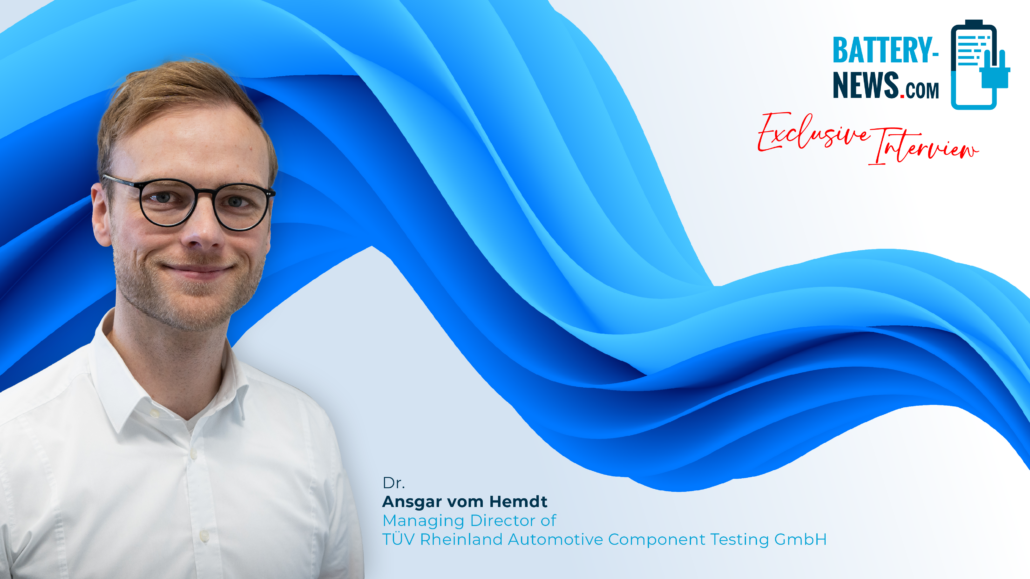If something goes wrong, it better happens during testing than during real operation. This applies even more to potentially dangerous “candidates” such as electric vehicle batteries. To make them a safe part of daily mobility, they are subjected to numerous different tests. “Despite major advances in the field of simulative validation, real-world testing remains indispensable,” says Dr. Ansgar vom Hemdt, Managing Director of TÜV Rheinland Automotive Component Testing GmbH, in an exclusive interview with Battery-News.
Battery-News: TÜV Rheinland has a reputation for the highest standards in certification and safety. How important is battery testing for the future of electric mobility and stationary energy storage, and what are the biggest challenges you see in the market today?
Dr. Ansgar vom Hemdt: Testing is an integral part of the battery development process. Despite major advances in simulative validation, it is still essential to subject the individual samples to real-world tests. Only by testing under realistic conditions can it be ensured that the product really does meet the quality requirements. This is another reason why legislators prescribe an extensive test catalog for the type approval of traction batteries. There are numerous challenges in the development and testing of batteries. In addition to high energy density and fast charging capability, one of the biggest challenges is to control thermal runaway in the battery system. To this end, legislators have once again tightened the requirements for type approval. In order to explain the current regulations and the different test methods for excluding hazards that may arise from electric vehicle batteries, together with the PEM Chair of RWTH Aachen University, we just recently published the free “Battery Testing in Accordance with UN Regulation No. 100 Revision 3” guide.
Battery-News: With the increasing demand for high-performance and long-life batteries, the pressure on manufacturers and testing institutions is also increasing. How do you ensure that TÜV’s test procedures can keep pace with the rapid development of battery technologies?
Dr. Ansgar vom Hemdt: The test procedures we use are always based on the currently valid standards and our customers’ specifications. Even during the development of our test laboratory, we worked out scenarios for how battery systems might develop. Accordingly, our test stands are designed to be flexible enough to take into account future battery technologies or changing test requirements.
“Our test stands are designed to realistically and repeatedly imitate extreme scenarios.”
Battery-News: Current research results show that thermal instability in lithium-ion batteries still represents a serious safety risk. How far has TÜV Rheinland progressed in developing test procedures that realistically and reproducibly deal with such extreme conditions?
Dr. Ansgar vom Hemdt: Our test stands are designed so that we can also realistically and repeatedly imitate extreme scenarios. In the respective procedure, we distinguish between function tests and abuse tests. A typical function test in this context is the overheating test, in which the battery is charged and discharged with high currents to cause targeted overheating. The battery management system switches off the charging/discharging process when a specific temperature limit is exceeded, thus preventing thermal instability from occurring in the first place. In addition, there are abuse tests, for example “thermal propagation” tests, in which individual cells or modules are deliberately caused to overheat. The manufacturers’ development goal is to prevent such a propagation of the battery system as far as possible and to alert a vehicle’s occupants in good time to a critical situation by means of a warning signal. Thermal propagation tests have become increasingly important in recent years.
Battery-News: But they are not mandatory, are they?
Dr. Ansgar vom Hemdt: No, these tests are not currently mandatory under European vehicle type approval regulations. However, TÜV Rheinland, together with partners in the relevant UN working groups, has been working on standardizing such tests. A proposal to this effect to supplement “Regulation 100 – Part II” has been on the table since the end of 2024. We expect it to be adopted in the course of 2025. This means that there will be a standardized framework with comparable and reproducible conditions. We ourselves have already placed great emphasis on reproducibility, but also on the environmental compatibility of abuse tests when designing our laboratory. That is why we only carry out these tests in our laboratory – and thus under controlled test room conditions – and not in the open air. This enables us to ensure that we have the same environmental conditions every time and that any pollutants that arise are treated.
“The standardization bodies are currently working on incorporating end-of-life battery issues into their standards.”
Battery-News: In industry, there is increasing discussion about end-of-life testing for batteries. How do you rate the current standards for testing recycled or reused batteries, and is there room for improvement?
Dr. Ansgar vom Hemdt: The big challenge in testing batteries for the secondary market is that they don’t come directly from standardized mass production with comparable quality levels but have an extensive first use behind them. It is therefore generally recommended that the battery be designed and protected for the subsequent application even before it is introduced to the primary market. In this case, end-of-life testing would then have to be carried out on the returned batteries to ensure that they still meet the requirements for a further life cycle. The standardization bodies are currently working on incorporating this new market development into their standards.
Battery-News: Battery manufacturers are increasingly focusing on fast-charging technologies. How robust are your test procedures with regard to these new requirements? Do you see any risks that have been underestimated?
Dr. Ansgar vom Hemdt: Current vehicle generations can charge at up to 300 kilowatts at peak times. Our test stands are designed to charge and discharge batteries with 500 kilowatts and more, and they can be expanded in a modular fashion. However, the pure peak power is actually secondary. It is more important to charge the battery with a high current for as long as possible in order to reduce the charging time. At these high currents, a sophisticated thermal management system is required in the battery to prevent it from overheating. Another challenge is the higher stress on the battery, which leads to faster aging as a result of the rapid charging processes.
“It lies in the responsibility of the recycling companies and the battery material manufacturers to ensure that the raw materials are of equivalent quality.”
Battery News: In view of the increasing demand for sustainable battery systems, recycling is becoming more and more important. What specific test procedures does TÜV Rheinland offer to ensure the quality of recycled batteries?
Dr. Ansgar vom Hemdt: It lies in the responsibility of the recycling companies and the battery material manufacturers to ensure that the raw materials are of equivalent quality. This quality can then be verified by an external testing laboratory. We at TÜV Rheinland ACT focus on testing complete battery systems. However, we don’t distinguish between batteries made from recycled raw materials and those made from newly extracted ones. The test requirements are always the same.
Battery-News: Where do you see the greatest further development of TÜV Rheinland in the field of battery testing? Which standards are essential for the future of battery technology?
Dr. Ansgar vom Hemdt: We are continuously working on the further development of our testing portfolio because we want to provide our customers with the best possible support for their own further development. It is important that we can also offer the appropriate testing options for tomorrow’s battery technologies. That is why we are constantly working on improving our processes in order to meet our customers’ requirements even faster and more efficiently.




